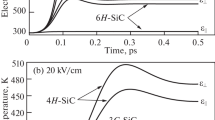Abstract
We studied the sensitivity of the steady-state electron transport in GaN to variations in the important material parameters related to the band structure. We found (a) that an increase in the lowest conduction-band-valley effective mass leads to a lowering and broadening of the peak in the velocity-field characteristic, as well as to an increase in the field at which the peak occurs; (b) that increases in the upper conduction-band-valley effective masses dramatically decrease the saturation drift velocity, with very little other effect; (c) that increased nonparabolicity of the lowest conduction-band valley leads to a broadening and shifting to higher electric fields of the peak in the velocity-field characteristic; (d) that increases in the intervalley energy separation lead to moderate increases in the peak drift velocity; and (e) that increases in the degeneracy of the upper conduction-band valleys leads to a moderate decrease in the saturation drift velocity.
Similar content being viewed by others
References
S. Strite and H. Morkoç, J. Vac. Sci. Technol. B 10, 1237 (1992).
H. Morkoç, S. Strite, G.B. Gao, M.E. Lin, B. Sverdlov, and M. Burns, J. Appl. Phys. 76, 1363 (1994).
S.N. Mohammad and H. Morkoç, Prog. Quant. Electron. 20, 361 (1996).
S.J. Pearton, J.C. Zolper, R.J. Shul, and F. Ren, J. Appl. Phys. 86, 1 (1999).
S. Nakamura, Mater. Res. Soc. Bull. 22, (2) 29 (1997).
M.S. Shur and M.A. Khan, Mater. Res. Soc. Bull. 22, (2) 44 (1997).
M.A. Littlejohn, J.R. Hauser, and T.H. Glisson, Appl. Phys. Lett. 26, 625 (1975).
D.K. Ferry, Phys. Rev. B 12, 2361 (1975).
B. Gelmont, K. Kim, and M. Shur, J. Appl. Phys. 74, 1818 (1993).
J. Kolník, I.H. Oguzman, K.F. Brennan, R. Wang, P.P. Ruden, and Y. Wang, J. Appl. Phys. 78, 1033 (1995).
M. Shur, B. Gelmont, and M.A. Khan, J. Electron. Mater. 25, 777 (1996).
B.E. Foutz, L.F. Eastman, U.V. Bhapkar, and M.S. Shur, Appl. Phys. Lett. 70, 2849 (1997).
U.V. Bhapkar and M.S. Shur, J. Appl. Phys. 82, 1649 (1997).
S.K. O’Leary, B.E. Foutz, M.S. Shur, U.V. Bhapkar, and L.F. Eastman, J. Appl. Phys. 83, 826 (1998).
S.K. O’Leary, B.E. Foutz, M.S. Shur, U.V. Bhapkar, and L.F. Eastman, Solid State Commun. 105, 621 (1998).
J.D. Albrecht, R.P. Wang, P.P. Ruden, M. Farahmand, and K.F. Brennan, J. Appl. Phys. 83, 1446 (1998).
N.G. Weimann, L.F. Eastman, D. Doppalapudi, H.M. Ng, and T.D. Moustakas, J. Appl. Phys. 83, 3656 (1998).
S.K. O’Leary, B.E. Foutz, M.S. Shur, L.F. Eastman, and U.V. Bhapkar, Mater. Res. Soc. Symp. Proc. 482, 845 (1998).
J.D. Albrecht, R.P. Wang, P.P. Ruden, M. Farahmand, and K.F. Brennan, J. Appl. Phys. 83, 4777 (1998).
E. Bellotti, B.K. Doshi, K.F. Brennan, J.D. Albrecht, and P.P. Ruden, J. Appl. Phys. 85, 916 (1999).
B.E. Foutz, S.K. O’Leary, M.S. Shur, and L.F. Eastman, J. Appl. Phys. 85, 7727 (1999).
S. Krishnamurthy, M. van Schilfgaarde, A. Sher, and A.-B. Chen, Appl. Phys. Lett. 71, 1999 (1997).
J.D. Albrecht, R. Wang, P.P. Ruden, M. Farahmand, E. Bellotti, and K.F. Brennan, Mater. Res. Soc. Symp. Proc. 482, 815 (1998).
B.E. Foutz, S.K. O’Leary, M.S. Shur, and L.F. Eastman, Mater. Res. Soc. Symp. Proc. 572, 445 (1999).
In the Kane model, the energy band of the Γ valley is assumed to be nonparabolic, spherical, and of the form \(\frac{{^2 k^2 }}{{2m}} = E(1 + \alpha E),\) where hk denotes the crystal momentum, E represents the energy above the minimum, m* is the effective mass, and the nonparabolicity coefficient, α, is given by \(\alpha = \frac{1}{{{\rm E}g}}\left( {1 - \frac{{m*}}{{m_e }}} \right)^2 ,\) where me and Eg denote the free-electron mass and the energy gap, respectively.26
W. Fawcett, A.D. Boardman, and S. Swain, J. Phys. Chem. Solids 31, 1963 (1970).
Piezoelectric scattering is treated using the well-established zinc-blende scattering rates, and thus, a suitably transformed piezoelectric constant, e14, must be selected. This may be achieved through the transformation suggested by Bykhovski et al.28
A.D. Bykhovski, V.V. Kaminski, M.S. Shur, Q.C. Chen, and M.A. Khan, Appl. Phys. Lett. 68, 818 (1996).
P. Lugli and D.K. Ferry, IEEE Trans. Electron. Dev. 32, 2431 (1985).
K. Seeger, Semiconductor Physics, 6th ed. (New York: Springer, 1997).
V.W.L. Chin, T.L. Tansley, and T. Osotchan, J. Appl. Phys. 75, 7365 (1994).
The longitudinal and transverse sound velocities are equal to \(\sqrt {\frac{{C_l }}{\rho }} {\mathbf{ }}and{\mathbf{ }}\sqrt {\frac{{C_t }}{\rho }} \) respectively, where C1 and Ct denote the respective elastic constants, and ρ represents the density.
H.P. Maruska and J.J. Tietjen, Appl. Phys. Lett. 15, 327 (1969).
All intervalley deformation potentials are set to 1×109 eV/cm, following the approach of Gelmont et al.9
We follow the approach of Bhapkar and Shur13, and set the intervalley-phonon energies equal to the optical-phonon energy, a relationship which holds approximately for GaAs.36
M.A. Littlejohn, J.R. Hauser, and T.H. Glisson, J. Appl. Phys. 48, 4587 (1977).
W.R.L. Lambrecht and B. Segall, in Properties of Group III Nitrides, No. 11 EMIS Datareviews Series, ed. J.H. Edgar (London: Inspec, 1994), p. 141.
To determine the nonparabolicity coefficient, α, we applied the Kane model to the central conduction-band-valley minimum, following Bhapkar and Shur.13,25,26 The nonparabolicity coefficient, α, corresponding to the upper conduction-band valleys, are set to zero, as they are assumed to be parabolic.
This selection of upper conduction-band-valley effective mass is larger than that found in Bhapkar and Shur13 and O’Leary et al.,14 and hence, the results are expected to be different.
We have nominally assumed that the first upper conduction-band valley is nondegenerate, i.e., g=1.
Author information
Authors and Affiliations
Rights and permissions
About this article
Cite this article
O’Leary, S.K., Foutz, B.E., Shur, M.S. et al. Steady-state electron transport in the III–V nitride semiconductors: A sensitivity analysis. J. Electron. Mater. 32, 327–334 (2003). https://doi.org/10.1007/s11664-003-0153-8
Received:
Accepted:
Issue Date:
DOI: https://doi.org/10.1007/s11664-003-0153-8




